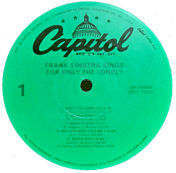Frank Sinatra Sings for Only the Lonely - 1958
Notes on Source Quality
Frank Sinatra Sings for Only the Lonely - 1958
Notes on Source Quality
There have been many hiccups on the road to release for assorted editions of Only the Lonely, both in mono (a few) and stereo (many).
MONO “ONE FOR MY BABY”
Let’s start with the mono releases, and, specifically, the song “One for my Baby (and One More for the Road).”
As far as I can tell, all of the mono releases of this album were issued without a hitch right up until the mono version was phased out around 1968, and continuing with the 1984 Dutch DMM mono release. If there are defective/problematic copies of the mono LP during the initial release period (1958-1968), I have neither heard them nor heard of them, but I cannot 100% rule out the possibility of their existence, and the 1984 Dutch release was problem-free. That said, a funny thing happened in 1985, seventeen years after the mono version was phased out of production. Jay Ranellucci, long-time Capitol staffer, was assigned the task of assembling masters for a Time-Life 2-LP set of highlights from Sinatra’s Capitol years titled LEGENDARY SINGERS. It’s a nice set, and a nicely mastered set, that relies heavily on the use of mono masters over stereo masters, with only one track appearing in stereo, even though several had been available in true stereo for decades. The set uses the mono recording of the song “One for my Baby” from ONLY THE LONELY, and something appears to have “sneaked past the goalies” at Capitol, at Masterfonics in Nashville (where the lacquers were cut at half-speed), and at Time-Life: There are a few seconds MISSING near the end of the song! (File this question away for later: Why didn’t they use the stereo mix? We’ll come back to that for a possible answer later.....) How odd!
Zoom ahead seven additional years to 1992, and EMI Australia’s “best of” compilation CD titled “The Essential Frank Sinatra.” The song “One for my Baby” appears, and again, the mono master is used. (Again: Why didn’t they use the stereo mix? We’ll come back to that for a possible answer later.) As with the Time-Life set, a few seconds of “One for My Baby” are missing, with the same abrupt jump as on the 1985 set. Here is audio from the Australian CD, and you’ll notice the jump with no problem: OneForMyBabyAustralianCDClip.mp3 (The Time-Life set contains identical content.)
Sixteen more years pass. 2008 rolls around, and MFSL gives the mono mix the audiophile release treatment (and they did a beautiful job of it). Everything sounds copacetic until the tail end of ONE FOR MY BABY, at the same spot where the problem occurred on the 1985 Time-Life LP and 1992 Australian CD releases, only this time, the tape problem is handled differently. Here’s the audio from the 24-karat gold CD release: OneforMyBabyMFSLCDClip.wav You can hear that the missing seconds were repaired, and over the duration of the repair, an extra layer of hiss is audible. Indeed, Mr. LoVerde was so kind as to reply about this situation via e-mail when asked:
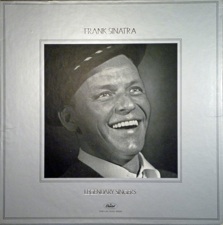
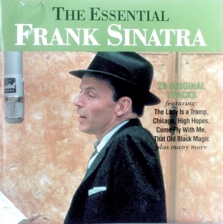
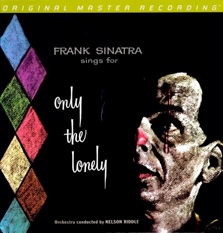

You may notice in the audio clips that there is significantly more tape hiss on the Australian EMI release than on the un-spliced sections of the MFSL. My guess is that at some point an analogue tape copy was sent to Australia, that being a copy of the already-broken master. The “safety master” used by MFSL was, of course, also a tape copy of the master, but one made, assumedly, prior to the tape damage occurring, so the spliced-in section on the MFSL CD has similar tape levels to the entire track on the Australian CD. For comparison, here is audio from the 1984 Dutch DMM mono LP, which is “clean.” OneForMyBabyDMMClip.wav
As there are no audible jumps in hiss levels on the coinciding MFSL LP release, one does wonder how the problem was overcome there. Scenarios include: 1. ) The entire song was cut from the safety copy; 2.) The LP was mastered before the CD was mastered AND before the break occurred, although the tape break’s existence on at least two earlier releases seems to quash this idea. My guess is that it was choice #1, but in the end, any speculation is strictly academic in nature, as the resulting LP sounds excellent, so really....who cares?
Aside from that one little defect, the mono mix is, as far as I can tell, free of quirks or defects.
STEREO “ONLY THE LONELY” (title track)
Here again is the drawing that appears on one of the three-track tape boxes for this album:

You can make out the labels: Bass, strings, ww (woodwinds), trumpets, trombones, percussion, and, circled in blue, rhythm. For every track except for the opening title track, this layout holds true, with the piano right of center, as circled. For the title track, however, another piano appears to be used, and it is stationed all the way at far left (NOT in the “rhythm” position indicated). You can hear the piano’s position at far left in this brief snippet from the song’s instrumental introduction: OTLOpenTCY.mp3 (Source: 1990 THE CAPITOL YEARS CD, remixed from the 3-track master by Ron Furmanek and Larry Walsh -- likely with the left channel turned up substantially to bring out the piano during the introduction.)
Remember: The stereo and mono versions are actually separate, simultaneously-made recordings, with about 10 microphones (including a piano “spot mic”) used for the mono recording, and three microphones used for stereo. From the 2008 MFSL CD, here is the same snippet in mono, with the close-miked piano being very prominent: OTLOpenMFSLMonoCDRedux.mp3
Next, compare those two audio clips with this one from the original stereo mix: OTLOpenMFSLsTereo.mp3 (Source: 1983 MFSL stereo LP.)
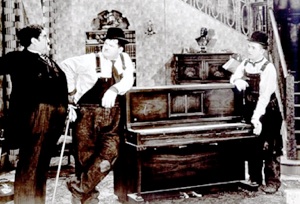
Clearly, somebody (Dave Cavanaugh?) thought that the far-left piano -- an exclusive feature on this song -- was not forward enough in the stereo mix, and the solution they came up with to solve the problem was to create an edit piece by briefly synchronizing the stereo and mono sources, with the mono mix panned to the center, effectively preserving a sense of stereo while also moving the piano to the center of the image. This specially-created edit piece runs for 23 seconds, from the beginning of the track until Frank’s initial vocal entrance, at which point there is a tape splice and the recording shifts to using the regular 3-track-to-stereo mixdown tape source, with the piano now pushed off to far left for the remainder of the track. Syncronizing the mono and stereo recordings as they did was quite unusual, but also quite well-executed and quite effective in boosting the piano level to a more soloistic volume vis-a-vis the rest of the orchestra.
I find it interesting that this course of action was deemed necessary in 1958, but has never been re-created for a stereo remix, even though it’s quite easy to re-create, meaning that on the stereo CD releases of this song, all of which are remixes, the piano volume in the introduction is a little low. Here is a brief clip that starts with the 1990 remix, which, to my ears, seems to have the left channel artificially goosed a bit, followed by the original stereo mix that utilizes that sneaky edit piece, combining the stereo and mono recordings. Note the shift in piano location: OTLOpenTCY-MFSLStereoLP.mp3.
Next, here is the original mono mix (2008 MFSL CD) followed by the original stereo mix (1983 MFSL stereo LP), and you can hear that the mono element is “embedded” in the stereo mix, with the piano maintaining its tonality across the mono and stereo mixes: OTLOpenMFSLMonoCD-MFSLStereoLP.mp3.
To further illustrate how easy it would be to re-perform this remix process in 2016, I went ahead and did it. Here is a clip that starts with the original stereo mix (1983 MFSL LP) and transitions into my new mix (1990 The Capitol Years mix, sync’d with the 2008 MFSL mono CD): OTLOpenMFSLStereo-Mine.mp3
STEREO “IT’S A LONESOME OLD TOWN”
This is one of the songs that is missing on the vast majority of stereo LP pressings, which only contain ten of the twelve songs recorded for the album. Even on the “12-song stereo” editions that started to appear in some markets beginning in 1968, this song, for some reason, appears in mono on some versions.
Stereo LP editions that contain the original stereo mix of this song
•Australian release #SENC-9394, 1968
•Dutch release #5C052.81179, 1971
•Australian release #S/5004, 1972
•Japanese release #ECP-80796, 1973
•UK “One for My Baby” release, circa 1973 (song order resequenced)
•Mobile Fidelity Sound Lab release #1-137, 1983 (boxed set only)
Stereo LPs that contain the original mono mix of this song
•UK release #ED 26 0139 1, 1984
•Dutch DMM release #1A 038 26 01391, 1984
Stereo LPs that are missing this track
•All others (abridged from 12 songs to 10)
STEREO “SPRING IS HERE”
Along with “It’s a Lonesome Old Town,” this is the other song that is missing on the vast majority of stereo LP pressings, which only contain ten of the twelve songs recorded for the album. On some of the 12-song stereo releases, the sound is fine; on one, tape dropouts plague the song nearly start to finish; on others, the channels are reversed, but with no dropouts.
Stereo LP editions that contain the original stereo mix of this song, free of tape damage
•Australian release #SENC-9394, 1968
•Dutch release #5C052.81179, 1971
•Australian release #S/5004, 1972
•Japanese release #ECP-80796, 1973
•UK “One for My Baby” release, circa 1973 (song order resequenced)
(Oddly, the original stereo release of this song was on the Duophonic release of “Frank Sinatra Sings Rodgers and Hart” in 1963, where it sounds quite good, despite being mildly compressed.)
Stereo LP editions that contain the original stereo mix of this song, but with significant, audible tape damage
•Mobile Fidelity Sound Lab release #1-137, 1983 (boxed set only)
Stereo LP editions that contain the original stereo mix of this song, but with channels reversed
•UK release #ED 26 0139 1, 1984
•Dutch DMM release #1A 038 26 01391, 1984
Stereo LP editions that are missing this track
•All others (abridged from 12 songs to 10)
On the 1983 MFSL release, the red sections below have dropouts, while the purple sections do not. As you can see, the tape damage affects nearly the entire song.
Below are two clips. (Click on the photos below to hear the audio.) One clip is from the 1972 Australian release, which is free of dropouts. The other from the 1983 MFSL stereo LP, which, as indicated graphically above, is essentially one continuous dropout from start to finish.)
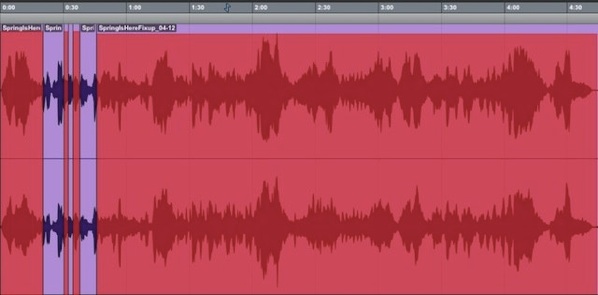
ABOVE: 1972 Australian LP
ABOVE: 1983 MFSL LP
STEREO “GONE WITH THE WIND” and “ONE FOR MY BABY”
These two songs, which are the final tracks on side two of the album, have identical release histories where their use on stereo LPs is concerned. Both tracks have been included on all editions since the stereo LP’s introduction in 1958 (neither was removed when the title roster was cut from 12 to 10 songs); both started to exhibit audible tape damage (dropouts) at some point during the 1970s. Here is a summary that applies to both songs:
Stereo LP editions that contain the original stereo mix of these songs, free of tape damage
•Internationally, all (?) stereo “Only the Lonely” LPs in print from 1958 through approximately 1977. After that date, things become less certain.
•In the North America, all of the SW- , ST-, and SY-series pressings (c. 1958-1974?)
•UK “One for My Baby” LP, circa 1973
•SM-series pressings (c. 1974-1980? -- regular and record club versions), but only through at least the 62nd lacquer cut (“H62” scribed in the runout groove area).
Unknown quality
•Cuts 63-66 are as yet undocumented. They may be fine....or not?
Stereo LP editions that contain the original stereo mix of these songs, but with significant, audible tape damage
•SM-series LPs (regular and record club versions) starting with lacquer #67 (“G67” scribed in the runout groove area), possibly going back as far as #63. (63-66 are as yet undocumented.)
•All SN-series pressings (circa 1981-1986?)
•Mobile Fidelity Sound Lab release #1-137, 1983 (boxed set only)
•UK release #ED 26 0139 1, 1984 (presumably cut from digital copy of USA stereo master)
•Dutch DMM release #1A 038 26 01391, 1984 (presumably cut from digital copy of USA stereo master)
The song “One for My Baby” was released in the UK in 1986, on an LP entitled “The Frank Sinatra Collection,” and on a 12-inch single released in conjunction with the LP. Both contain the dropouts. When the LP was reissued on compact disc one year later, the then-new Larry Walsh remix versions replaced the original mixes found on the vinyl releases.
GONE WITH THE WIND, tape damage areas shown in red:
ONE FOR MY BABY, tape damage areas shown in red:
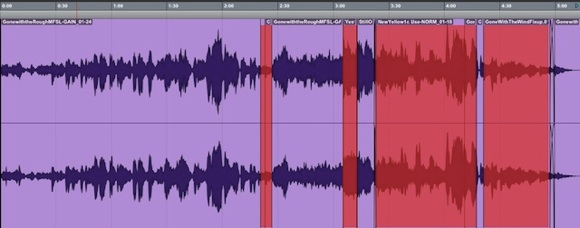
Short answer: I do not know! However, I will offer up a speculative possibility (nothing more).
Despite all the talk of “master reels” for Sinatra/Capitol recordings, “reels” is not quite a technically accurate terms, as Capitol was not using “reels” at the time. Rather, master tapes were typically stored as “pancakes.”
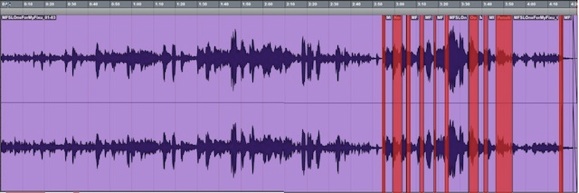
So...what’s the deal with all the tape defects?


the pancake from whence it came. If the tape box containing a pancake were to be dropped from, say, table height, it’s logical that the tape would have spilled from the outside, i.e, from the END of the LP side. Note that three songs exhibit tape damage on side two, those being “Gone with the Wind” and “One for My Baby,” which conclude the album side, plus.....well, how did “Spring is Here” get damaged, and severely damaged, at that? To reiterate: I DO NOT KNOW, but it’s certainly *possible* that the stereo master for SPRING IS HERE, which was only utilized on a handful of releases, was stored at the end of the side two “reel,” ready to be spliced in, if needed. AT LEFT is a photo showing an instance of this very sort of thing happening on a major label release. (I’ve clumsily covered the song title and engineer’s initials on the tape box photo to protect the innocent.) When that tape is used for LP cutting, the final song -- the one that is “at end after red leader” -- is simply skipped over and not cut to disk, remaining safely stored, should it ever be needed down the road sometime. *IF* this sort of thing happened with side two of ONLY THE LONELY, then “Spring is Here” would have been stored at the edge of the pancake, following “One for My Baby,“ “ready for duty,” if needed, so it’s logical that it would have succumbed to the most tape damage of the three songs involved, which is, indeed, the case. (See graphs up-page.) To re-iterate: This is SPECULATION ONLY, but it’s a logical possibility.
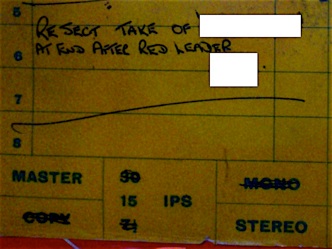
One possible explanation for the re-appearance of a damage-free SPRING IS HERE without dropouts on the two 1984 editions -- but with channels reversed -- is that somebody involved in the projects heard the tape, realized that it was damaged almost literally from start-to-finish, and made a digital dub of some sort of a safety/backup master source, possibly (?) using the 1963 “Frank Sinatra Sings Rodgers and Hart” master. At some point during a dubbing process, left and right got swapped out, and nobody noticed, apparently. “Oops” happens!
Final answer: I HAVE NO IDEA, but I wouldn’t rule these things out.
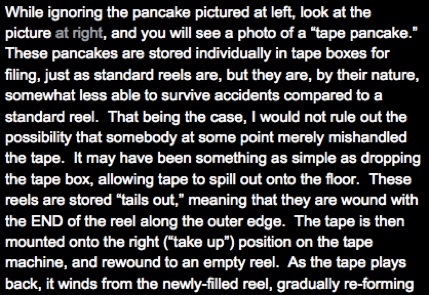
One more thing about “One for My Baby”
The album closes dramatically in both the mono mix and the original stereo mix. In mono, Frank’s vocal level slowly drops until he just kind of drifts into the ether. In the original stereo mix, Frank “exits stage right” (or “exits stereo left,) with the vocal track slowly moving from the center position to far left. It’s a neat, very intentional effect that, sadly, has never been recreated on any of the stereo remixes for this tune, meaning that, if you want to hear the end of the album with the original production ideas intact, you need to track down a mono release or a stereo LP. Here are clips, in this order: 1.) Original mono (MFSL CD); 2.) Original stereo (1983 MFSL LP); 3.) 1987 Walsh Remix CD; 4.) 1998 Norberg Remix CD: OneEndMFSLMONO-MFSLStereo-Walsh-Norberg.mp3. (Thanks to “rangerjohn” for the Norberg clip.)

To the best of my knowledge, the final uses of the original stereo mixes for tracks from this album occurred in 1986, when “Blues in the Night” appeared on the Australian 2-CD set, THE FRANK SINATRA COLLECTION (two cover variations pictured at far left), and “One for My Baby” appeared on a British LP also titled, coincidentally, THE FRANK SINATRA COLLECTION (two cover variations at near left). The availability of the 10-song ONLY THE LONELY stereo LP in the USA came to an end right around this time, as well (final label variation at center left), meaning that, effectively, with the creation of a new stereo version remixed from the 3-track session tapes by Capitol’s Larry Walsh, the original stereo mix was retired worldwide, and all releases from 1987 onward use a remix.
1987 and beyond: CD Remixes and Noise Reduction
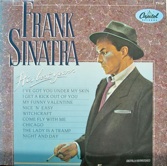
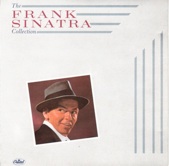
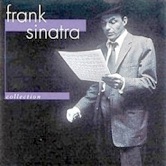
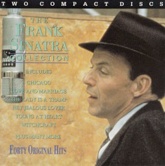
In my opinion, the 1987 remix performed by Larry Walsh is, on the whole, pretty well done. (Remixes are always tricky, as they invariably involve change, and people sometimes don’t like change.) There are a couple of little nit-picky things that I wish were handled differently, but that’s minor stuff. The only real downside, to my ears, is the introduction of noise reduction, puttling a slight audio blanket over things. By contrast, the 1998 remix by Robert Norberg is “noise reduction on steroids,” to the point that it just sucks the life out of the music.
Here is a clip from the old version of this site, highlighting guitarist Al Viola’s introduction to “Guess I’ll Hang My Tears Out to Dry.” You’ll hear the same clip in five guises: 1.) The 1960 7.5 ips reel-to-reel release, which, due to the format itself, has at least two additional layers of tape hiss; 2.) The 1958 stereo mix (from the MFSL LP); 3.) The 1987 Walsh remix CD; 4.) The 1998 Norberg remix CD; 5.) The 1958 mono recording (from the MFSL CD). CLICK THE PHOTO AT RIGHT TO HEAR THE AUDIO.
How noise-reduced is the Norberg version? It’s severely noise-reduced and also processed to the point of adding distortion. Here is a brief clip from the 1983 MFSL LP, repeated from the Norberg CD: OneForMyBabyClip1983MFSL-Norberg.wav. That 1998 Norberg remix has been the in-print stereo release in North America for eighteen years now.
In the liner notes to the 1990 set, THE CAPITOL YEARS, author Pete Kline states:
<<It should be noted that the original stereo tapes contained more background hiss than usual. It seems that 3M had provided some new and experimental tape, which did not quite match-up properly with Capitol’s recording machines....The [1987 Walsh] CD, with Sonic Solutions “No-Noise” enhancement is a much improved stereo version....>> I do not doubt Mr. Kline’s forthrightness or good intentions regarding the statement about 3M, but I find it very, very hard to believe that anybody would agree to “experiment” with new tape formulations on an LP project for Sinatra, who was, arguably, Capitol’s marquee artist. Experiment with new tape on a Les Brown album? Maybe. Frank Sinatra? Highly unlikely. Rather, here is what I think happened:
The stereo recording, remember, is, in terms of the orchestra, a two-mic recording. (Sinatra is all alone on his own track on the 3-track tape.) Nothing is spot-miked. That being the case, you really can’t sit at the mixing console and “gain ride” the orchestra, turning its volume, en masse, up and down. Look at Mercury Records’ groundbreaking stereo recordings. The approach: Set levels for the highest-volume part of the recording, and then don’t touch levels again. The insures that the loudest parts will not distort. The downside? Quiet sections will have more-apparent tape hiss, as the signal is not being boosted to override the hiss levels. Dynamics will be unfettered and wide. WHERE ARE YOU was recorded in similar style to ONLY THE LONELY, but with a much smaller, more string-centric orchestra, somewhat uniform in texture, and with less overall dynamic variation. COME FLY WITH ME was also a minimally-miked recording in stereo, but with very, very few super-quiet sections, so again, the hiss situation is largely masked by musical content. ONLY THE LONELY, meanwhile, has a very large orchestra playing with a vast array of textures and volume levels, textures that include, literally, vocal with solo guitar and vocal with solo piano, and furthermore, because of the two-mic style employed on the orchestra, that solo guitar and solo piano are something like 25 feet (!) away from the closest microphone, and it’s not even a directional microphone. In terms of the texture of the accompaniment, nothing like that appears on those two earlier, similarly-miked recordings. Al Viola’s famous solo guitar passage quoted above is roughly 18 dB below the peak levels within that same song, and probably more like 24 dB below the peak level for the album as a whole. Not only is that going to fail to effectively mask hiss on the original 3-track tape, but the problem is exacerbated when mixing down from un-gain-ridden 3-track tape to un-gain-ridden 2-track tape. Of course, more hiss will be audible in those spots, and, to further illustrate the point, during “medium volume” full-orchestra sections, the recordings on this album are no more or no less “hissy” than medium-volume full-orchestra spots on WHERE ARE YOU or COME FLY WITH ME.
Had mixer Rex Uptegraft in the stereo booth chosen to do any knob-twiddling or gain-riding while recording the orchestra with only two mics, the changes would have absolutely, audibly drawn attention to themselves. (“Lets turn up the left mic” = “Let’s turn up the ENTIRE left half of the orchestra.” It would sound very unnatural, the equivalent of taking a stereo classical recording and playing with the balance knob during playback. Listeners would notice!) The orchestra was essentially approached as a “classical recording session” orchestra, despite its context within a pop recording. The mono mix is “knob twiddled” to a degree, but the stereo mix, using only two mics, is presented more-or-less “naked” in its original stereo mix. (Any compression/limited added during cutting can only add to the problems.)
ENOUGH RAMBLING! Let’s pick a “winner” for this title. Please continue to page six.
